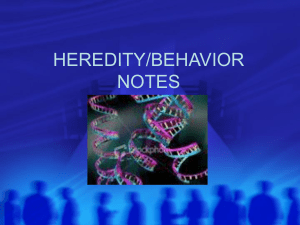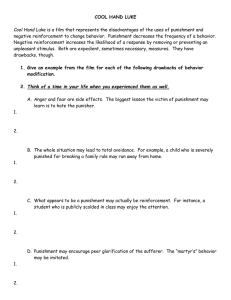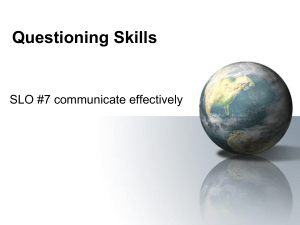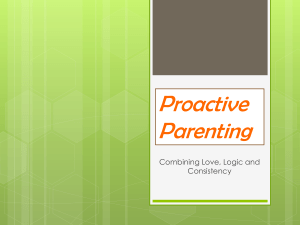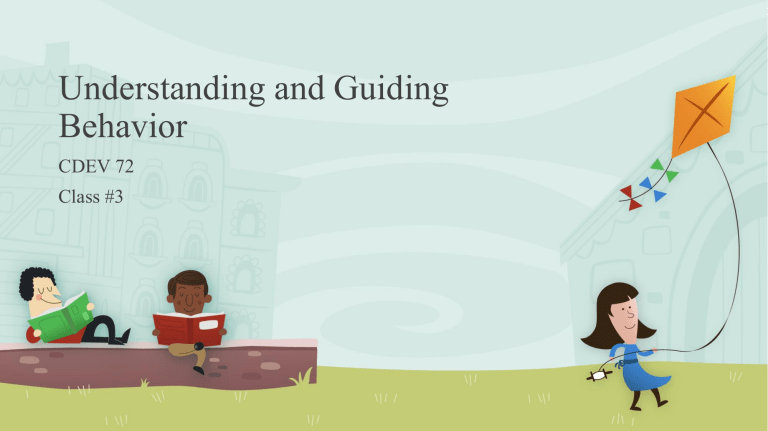
Understanding and Guiding Behavior CDEV 72 Class #3 Guidance or Discipline? • What is the difference between guidance and discipline? • Most people think of discipline as punishment, and guidance as a kind way to guide or lead someone else • However, both words are about teaching with our actions and words • When working with children, we should focus on guidance • If we use the term “discipline” we should remember that it does not have to involve punishment Positive Guidance • Whenever possible, we should focus on positive guidance • Instead of telling children what they CANNOT do, tell or show them what they CAN do • If you see a child throwing toys in the classroom, resist the temptation to say, “No throwing!”. Instead try, “It looks like you really want to throw things. Let’s go outside and find a ball for you to throw.” • If a child is running inside, remind them to “use your walking feet”, or “indoor feet” instead of “no running” • It is hard to make the transition to positive guidance, and it takes more effort than just saying “no”, “stop”, or “don’t” • Be patient with yourself, and the children, as you practice using positive guidance on a consistent basis No Child Misbehaves on Purpose! • When I took CDEV courses I had a teacher who kept repeating that phrase • She explained that when a child misbehaves there is always a reason for it – and that reason is simply because they want to drive us crazy! • Perhaps a child is hungry or tired, and that is causing them to be cranky or irritable, and “mean” to their classmates • Maybe a child has been waiting a very long time for a turn on the tricycle, and their ability to wait has just run out • There are so many reasons why a child might behave in a “less than ideal” way Guidance Strategies • Decide who needs to win • Do I really need to win this argument, or can I let the child win? • Offer choices • Offer two options that you are okay with • Keep expectations realistic • Think about how old the child is, and what the child is being expected to do • Provide an appropriate environment • Keep the environment safe and age appropriate Guidance Strategies • Think about what the child needs in that moment • What is the child trying to “tell” you with his actions? • Don’t say “okay” • If you’re not looking for approval from the child, don’t ask for it! • Don’t expect children to share! • Humans don’t instinctively share – try taking turns instead • Don’t force children to apologize • When we tell children they must apologize they learn that it’s okay to hurt others as long as they say they’re sorry Guidance Strategies • Express your expectations clearly and firmly • Just state what you expect – long, drawn-out explanations are not necessary • Get down to the child’s level • Lower yourself so you are level with the child – it’s easier for the child to hear you if you aren’t towering over him • Put a hand on the child • This DOES NOT mean that you should hit or physically harm the child!! • Sometimes a child is able to focus better if they have physical contact with another person • Try putting your hand on the child’s shoulder to help “center” him Reinforcement v. Punishment • Positive Reinforcement • Goal is to INCREASE the desired behavior • Give something the child sees as good • Negative Reinforcement • Goal is to INCREASE the desired behavior • Take away something the child sees as bad • Punishment • Goal is to DECREASE the undesirable behavior • Give something the child sees as bad OR take away something the child sees as good Reinforcement takes more effort on the part of the adult, but it is far more effective than punishment As desired behaviors are increased, undesirable behaviors decrease Natural Consequences v. Logical Consequences • A natural consequence is one which happens naturally • If you don’t eat breakfast before school, you will likely be hungry earlier than lunch time • A logical consequence is used when a natural consequence isn’t practical • If a child throws sand, after being reminded to keep the sand low, he/she has to leave the sandbox and find another activity • Keep in mind, an adult usually needs to help a child with the logical consequence – generally a child will not decide to leave the sandbox on his own after throwing sand Time Out • Originally used in mental institutions • Moved into classrooms as hitting children became a less popular option (yes, teachers used to hit children!) • Frequently used in home settings Reasons Time Out Doesn’t Work • External controls v. internal controls • Adults’ needs are met, but not the child’s needs • Child’s self-worth and self-confidence diminish • Child is confused about how his/her actions led to time out • Lost opportunity for learning Alternatives to Time Out Anticipation Redirection Clear guidelines Consistent consequences


